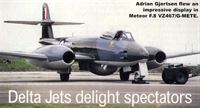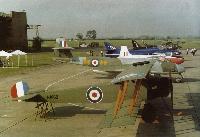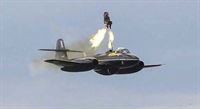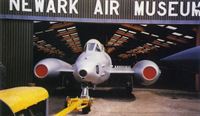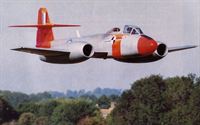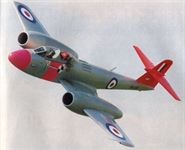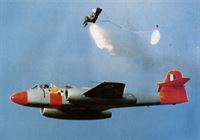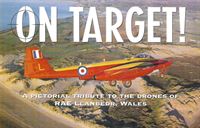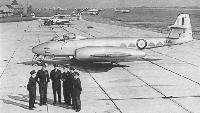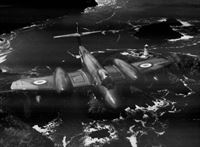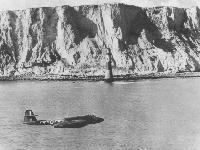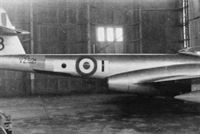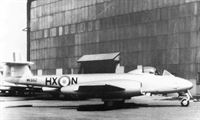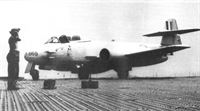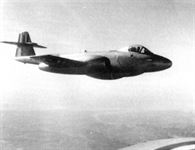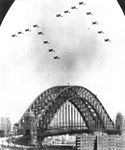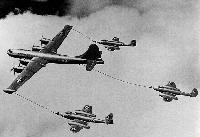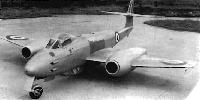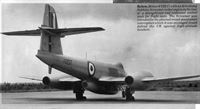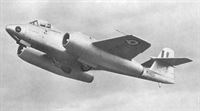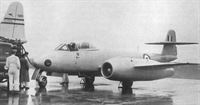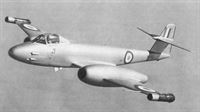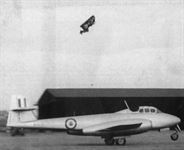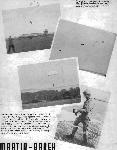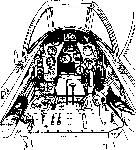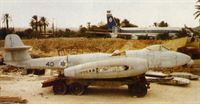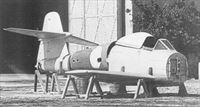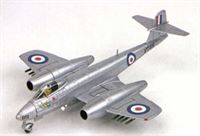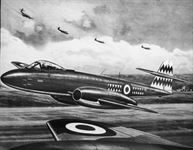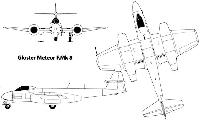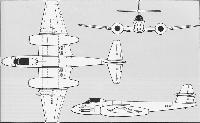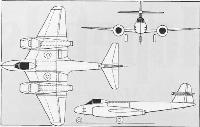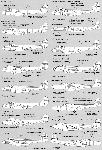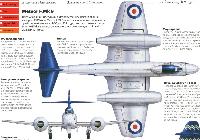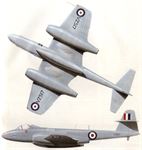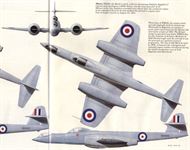
Варианты
- Gloster - Meteor / G.41 - 1943 - Великобритания
- Gloster - Trent-Meteor - 1945 - Великобритания
- Gloster - Meteor F.Mk.8 / FR.Mk.9 - 1948 - Великобритания
- Gloster, Armstrong Whitworth - Meteor NF.11 - 1950 - Великобритания
Gloster Meteor
<...>
Самой многочисленной модификацией стал Meteor F.Mk 8, который имел удлиненный фюзеляж, измененное хвостовое оперение, дополнительный топливный бак емкостью 432 л и цельноштампованный фонарь кабины. Среди дополнительно установленного оборудования также имелись гироскопический прицел и катапультное кресло Martin-Baker, самолет был оснащен двумя ТРД Derwent 8 тягой по 16,01 кН, что позволяло развивать предельную скорость почти до 966 км/ч. Первый из 1183 таких Meteor F.Mk 8 поднялся в воздух 12 октября 1948 года.
Кроме того, для решения задач тактической разведки на основе модели F.Mk 8 был создан низковысотный разведчик Meteor FR.Mk 9, имевший аэрофотоаппарат в носовой части и сохранивший вооружение предшественника. Были построены 126 таких самолетов, первый поднялся в воздух 22 марта 1950 года. Следом появилась невооруженная модификация машины для полетов на большой высоте, получившая обозначение Meteor PR.Mk 10 - гибрид с крылом от F.Mk III, хвостовым оперением от F.Mk IV и фюзеляжем от FR.Mk 9. Первый из 58 построенных самолетов такого типа поднялся в воздух 29 марта 1950 года.
<...>
В числе прочего на базе Meteor были созданы беспилотные самолеты-мишени Meteor U.Mk 15 и U.Mk 16 - они были сконструированы на базе планеров самолетов моделей F.Mk IV и F.Mk 8 соответственно. Модификация Meteor U.Mk 21 была аналогичным образом переделана из F.Mk 8 и использовалась на полигоне Вумера в Австралии. Самолеты NF.Mk 11, оборудованные для буксирования мишеней, в Королевских ВМС Великобритании получили обозначение Meteor TT.Mk 20.
- Gloster Meteor
Фотографии
-
Air International 1982-05 / Model enthusiast
Регистрационный номер: WF714 [3] Meteor F Mk 8 WF714 as marked for use by the CO of No 500 Squadron, RAuxAF (Sqn Ldr Desmond de Villiers) at RAF West Mailing, 1954.
-
Мировая Авиация 188
Регистрационный номер: WF714 [3] Meteor F.Mk 8. Первые машины поступили в Истребительное командование в августе 1949 года. Meteor F.Mk 8 оставался основным дневным истребителем британских ВВС до 1954 года, затем его сменил Hunter. Многие F.Mk 8 влились во вспомогательную авиацию - Royal Auxiliary Air Force.
-
Мир Авиации 1995-02 / И.Сеидов - "Метеоры" терпят фиаско /Война в воздухе/
Регистрационный номер: A77-728 [2] Meteor Mk.8 из 77 аэ RAAF.
-
Мир Авиации 1995-02 / И.Сеидов - "Метеоры" терпят фиаско /Война в воздухе/
Регистрационный номер: A77-851 [2] Meteor Mk.8 "Halestorm", принадлежавший одному из лучших австралийских пилотов 77 аэ RAAF Джорджу Хейлу, Корея, 1952г.
-
Авиация и Космонавтика 2002-03 / В.Котельников - Глостер "Метеор" (2)
Регистрационный номер: A77-851 [2] "Метеор" F.Mk 8 сержанта Джорджа Хэлла, 77-я эскадрилья ВВС Австралии, Корея, март 1953г.
-
Air International 1982-05 / Model enthusiast
Meteor F Mk 8 of Eskadrille 742, Royal Danish Air Force, at Karup in 1954.
-
Air Pictorial 2000-05 / D.Nicolle - Canberra down!
Gloster Meteor F.8 of the Syrian AF, Suez period, 1956
-
Aeroplane Monthly 1996-03 / B.Jones - Trials and Testbed Meteors (2)
Регистрационный номер: RA490 [6] RA490, a Mark IV which underwent considerable modifications during its life. It is shown, with Nenes ahead of the front spar, as engaged in a joint NGTE/RAE programme to investigate jet deflection in respect of reducing stalling speeds of jet aircraft.
-
Мировая Авиация 57
Регистрационный номер: VZ608 Meteor FR.Mk 9. Изображен Meteor FR.Mk 9 из 208-й эскадрильи, которая в 1951-1958 годах базировалась в зоне Суэцкого канала, на Мальте и на Кипре. Эскадрилья действовала в интересах британских войск на Среднем и Ближнем Востоке.
-
Мир Авиации 1996-01 / В.Котельников - Метеор /Авиадосье/
Meteor FR.9 израильских ВВС, 1955г.
-
АвиаМастер 2002-02 / С.Степанов - "Зарубки на прикладе" /Боевая палитра/ (10)
"Метеор" FR.9 из 117-й эскадрильи ВВС Израиля, пилот - капитан Аарон Йоэли, осень 1955г.
-
Air International 1982-05 / Model enthusiast
Регистрационный номер: WH284 [2] Meteor U Mk 16 WH284 drone conversion of a Mk 8 for use at RAE Llanbedr.
-
Мировая Авиация 188
Регистрационный номер: WH284 [2] Этот F.Mk 8, № WH284, был построен компанией "Armstrong Whitworth" и позже переоборудован в U.Mk 16 - перед передачей в Королевский авиационный НИЦ в июне 1960 года.
-
Aeroplane Monthly 1996-11 / B.Jones - Trials and Testbed Meteors (6)
Регистрационный номер: VW411 [4] A true indication of the Meteor’s adaptability: VW411 came off the production line as a T.7, but later had its tail unit replaced with a Mk 8 version and the production nose substituted by a PR.10 section. It flew with only the front camera window operative during a career spent at several research establishments and is shown in the final paint scheme adopted in the mid-1960s.
-
Aeroplane Monthly 1996-05 / B.Jones - Trials and Testbed Meteors (3)
Регистрационный номер: WA634 [9] WA634’s first modification by Martin-Baker in 1953, to enable live testing of the company’s Mk 3 zero-height ejection seat.
-
Aeroplane Monthly 1996-05 / B.Jones - Trials and Testbed Meteors (3)
Регистрационный номер: WA634 [9] The aircraft was eventually modified in 1962 for testing the lightweight Mk 4 seat, which was rocket-propelled to facilitate escape from highspeed aircraft, both at ground level and at operational altitude.
-
Aeroplane Monthly 1996-11 / B.Jones - Trials and Testbed Meteors (6)
Регистрационный номер: WL419 [9] Martin-Baker’s much modified Mk 7 WL419, one of the small handful of Meteors still in operational use. This has the enlarged intakes. Before this career, it flew as shown here and, as such, is one of the few examples of a British serial number being positioned on a Meteor’s fin - the others, so far as it has been possible to ascertain, being Royal Navy T.7 WL353 and the 20 NF.11s converted by ML Aviation to TT.20s, again for the Royal Navy.
-
Aeroplane Monthly 1996-07 / B.Jones - Trials and Testbed Meteors (4)
Регистрационный номер: WA820 [7] WA820, the Mark 8 which, with two Armstrong-Siddeley Sapphire 2 engines each developing 7,600lb thrust, was the most powerful of all Meteors to fly. One Sapphire provided more thrust than the combined output of two standard Derwent 8s and enabled the aircraft to capture four time-to-height records on August 31, 1951.
-
Aeroplane Monthly 1996-07 / B.Jones - Trials and Testbed Meteors (4)
Регистрационный номер: WA982 [5] WA982, Rolls-Royce’s Meteor Mk 8, here shown when used as the flying testbed for the company’s Soar lightweight expendable turbojet, which was envisaged as the powerplant for projects on the drawing boards of several aircraft manufacturers in the 1950s. Being from an early production batch, the aircraft retained the smaller-diameter intakes for its standard Derwent 8 engines.
-
Aeroplane Monthly 1996-11 / B.Jones - Trials and Testbed Meteors (6)
Регистрационный номер: VZ517 [3] Side-view of VZ517, the Mk 8 adapted as the flying testbed for the Screamer rocket engine. This variable-thrust unit was to be the rocket part of the Avro 720 mixed-power interceptor. However, as the LOX/kerosene fuel system was not unanimously accepted for everyday squadron use by the RAF, the Avro 720 was cancelled and the Screamer became another footnote in aviation history.
-
Aeroplane Monthly 1996-07 / B.Jones - Trials and Testbed Meteors (4)
Регистрационный номер: WK935 [14] WK935, the unique trials aircraft originally built by Armstrong-Whitworth at Baginton to evaluate a prone-pilot requirement for the Bristol 185 interceptor project of 1952. The Bristol design evaporated long before WK935 flew but the Institute of Aviation Medicine at RAE Farnborough used the aircraft to test the principle as a general research programme. The last of 429 Mark 8s built by AWA, it featured the redesigned and enlarged engine intakes introduced during the mark’s production runs at both Baginton and Hucclecote.
-
Aeroplane Monthly 1998-09 / M.Oakey, T.Harmsworth - Vintage news
Регистрационный номер: G-METE [8], VZ467 [8] Contrary to reports elsewhere that Gloster Meteor F.8 VZ467/G-METE Winston (seen here being landed by Stan Hodgkins at Kemble at 1800hr on May 29, 1998, in time for the air display that weekend) is going overseas, its future is undecided. Delta Engineering is checking it over with a view to keeping it airworthy; subject to these checks, it is possible but not definite that it may go to the USA.
-
Aeroplane Monthly 1999-06 / M.Oakey, T.Harmsworth - News
Регистрационный номер: G-METE [8], VZ467 [8] The world's only flying Meteor F.8, VZ467 G-METE, better known as Winston, took to the air again at Kemble on April 9, 1999 in the hands of Martin-Baker chief pilot Stan Hodgkins. Delta Jets has overhauled the 1949-vintage Meteor, which arrived at Kemble 11 months ago; the aircraft will now begin a full flight test programme.
-
Aeroplane Monthly 2000-07 / News
Регистрационный номер: G-METE [8], VZ467 [8] Adrian Gjertsen flew an impressive display in Meteor F.8 VZ467/G-METE.
-
Air Pictorial 1994-08
Регистрационный номер: VZ467 [8], G-METE [8] A Meteor base in the 1950s, Biggin welcomed VZ467 back for the show, superbly finished in No 615 RAuxAF Sqn colours
-
Air Enthusiast 1995-09 / ??? - Flixton Pictorial
Регистрационный номер: WF643 [2] Gloster Meteor F.8 WF643 was built by Armstrong Whitworth at Baginton and was issued to 56 Squadron at Waterbeach on July 3, 1951. With the arrival of Supermarine Swifts with No 56, WF643 transferred to 1 Squadron at Tangmere in 1954 and to 611 Squadron at Hooton Park in 1955. Placed in storage in 1957, it joined the Station Flight at Nicosia 1960 until joining up with 29 Squadron at the base in 1963, moving on to Akrotiri. WF643 again wears its markings from its Cyprus days. With replacement by Javelins, retirement came in October 1965, going into storage at Kemble. Moved to Coltishall in 1973, WF643 looked set to end its days on the fire dump until rescued by N&S and moving to Flixton in May 1975.
-
Air Pictorial 1999-12 / R.Lindsay - A Sharp Operation
Регистрационный номер: WK864 Part of the static display at the base in July 1999 to celebrate 1 FTS’ anniversary. The Avro 504 replica, Meteor F.8, Jet Provost T.4 and Hunter T.7 were all from the Yorkshire Air Museum at Elvington. At the end of the line is a Hawk T.1A and Slovenian Bell 412EP.
Другие самолёты на фотографии: Avro Avro 504 - Великобритания - 1913Bell Model 412 / UH-1Y - США - 1979Embraer EMB-312 / AT-27 Tucano - Бразилия - 1980Hawker Hunter T - Великобритания - 1955Hunting Percival Jet Provost / P.84 - Великобритания - 1954
-
Aeroplane Monthly 1996-07 / 1996 UK Aircraft Collections and Museums Guide (1)
Регистрационный номер: WK654 The City of Norwich Aviation Museum’s Gloster Meteor F.8, WK654, on the north side of what was RAF Horsham St Faith - and is now Norwich Airport.
-
Jane's All the World Aircraft 1980 / Encyclopedia of Aviation - Aircraft A-Z - v3
Регистрационный номер: WH364 [3] Gloster Meteor F.8.
-
Мировая Авиация 188
На войне в Корее 77-я эскадрилья ВВС Австралии вначале действовала на самолетах Mustang, но в 1951 году получила Meteor F.Mk 8. На F.Mk 8 австралийцы сбили, как утверждается, не менее четырех МиГ-15. Самолеты Meteor очень сильно уступали МиГ-15, и это выявилось очень быстро, но в качестве истребителей-бомбардировщиков F.Mk 8 оказались достаточно эффективны.
-
Aviation Historian 34 / M.Napier - The pale blue line
A busy scene at Kimpo circa late 1951, with Gloster Meteors of the Royal Australian Air Force’s No 77 Sqn in the distance and glass-nosed all-black Douglas B-26 Invaders to the right. The Australians began the Korean conflict with P-51 Mustangs, but acquired the Meteor F.8s from the UK and deployed 22 at Kimpo from July 1951.
Другие самолёты на фотографии: Douglas A-26 / B-26 Invader - США - 1942
-
Авиация и Космонавтика 2002-03 / В.Котельников - Глостер "Метеор" (2)
Регистрационный номер: A77-854 "Метеор" F.Mk 8 из 77-й эскадрильи ВВС Австралии, аэродром Кунсан, Корея, 1953г.
-
Авиация и Космонавтика 2002-03 / В.Котельников - Глостер "Метеор" (2)
Регистрационный номер: A77-868 -
Aeroplane Monthly 1994-02 / M.Oakey - Grapevine
Регистрационный номер: A77-867 Seen at Parafield, South Australia, on the occasion of the inaugural Wings and Wheels challenge on November 14, 1994, is Gloster Meteor F.8 A77-867. It carries the green-and-white chequered tail and wingtip markings of 77 Sqn RAAF, which operated Meteors in Korea.
-
Air Enthusiast 2003-09 / T.Buttler - Through the master's lens
Syrian Meteor F.8s on air test. Twelve new-build examples were supplied in late 1952/early 1953. These were followed by seven refurbished RAF F.8s in 1956.
-
Мировая Авиация 179
Регистрационный номер: WH364 [3] На закате своей карьеры значительное количество Meteor F.Mk 8 было переоборудовано в буксировщики мишеней и учебно-тренировочные машины. Буксировщики мишеней неофициально обозначали F(TT).Mk 8, а учебно-тренировочные самолеты - как T.Mk 8. Оба варианта имели хорошо заметную окраску. Здесь изображен T.Mk 8 из 85-й эскадрильи в ярко-оранжевой окраске и Lightning из 5-й эскадрильи.
Другие самолёты на фотографии: English Electric / BAC Lightning - Великобритания - 1957
-
Air Enthusiast 1999-03 / A.Warnes - Hatzerium album
Unrivalled assembly of Meteors. From the rear: a pair of T.7s (18 and 15); hybrid T.7 21 with T.8 tail unit; NF.13 157 (4X-FNE); NF.13 51 (4X-FND) and F.8 06.
Другие самолёты на фотографии: Gloster Meteor / G.41 - Великобритания - 1943Gloster, Armstrong Whitworth Meteor NF.11 - Великобритания - 1950
-
Air International 2022-11 / T.Fish - Escape Velocity
Martin-Baker’s long-serving, specially modified Gloster Meteor has been in use for decades to test the company’s ejection seats, operating from the company airfield at Chalgrove, Oxfordshire. After a period of eight years during which no tests were carried out, on June 18, 2018, Martin-Baker announced that it had resumed these activities
-
Aeroplane Monthly 2000-04 / 2000 Airshows & Museums Guide
The Newark Air Museum’s Meteor FR.9, VZ608, going into the exhibition hall minus outer wings. It was used for RB.108 jet-lift engine flight testing.
-
Мировая Авиация 179
Регистрационный номер: WA634 [9] Этот WA634 - один из первых Meteor, получивших хвостовое оперение типа E.1/44, которое затем стало стандартным на Meteor Mk 8. Одним из основных недостатков учебно-тренировочных самолетов Meteor был фонарь кабины с частым переплетом, что ограничивало обзор из кабины. Лишь с варианта NF.Mk 14 стали использовать новые фонари, обеспечивавшие хороший обзор.
-
Aeroplane Monthly 1996-03
Регистрационный номер: WL419 [9] RICHARD PAVER photographed Martin-Baker's ejection-seat test Meteor WL419 at 8,000ft over Chaigrove and Oxford on October 8, 1995. The Meteor pilot was Stan Hodgkins, and the photograph was taken from a Harvard flown by Peter Monk.
-
Aeroplane Monthly 1996-05 / B.Jones - Trials and Testbed Meteors (3)
Регистрационный номер: WL419 [9] Baker's ejection-seat test Gloster Meteor WL419 at 8,000ft over Chaigrove and Oxford on October 8 last year. WL419 was being flown by Stan Hodgkins, and is scheduled to make a rare airshow appearance at the Old Flying Machine Company's Classic Jet and Fighter Display at Duxford on June 2, 1996.
-
Aeroplane Monthly 1996-11 / B.Jones - Trials and Testbed Meteors (6)
Регистрационный номер: WL419 [9] WL419 makes a low pass at Chaigrove, revealing scorch marks round the rear seat area.
-
Aeroplane Monthly 1996-11 / B.Jones - Trials and Testbed Meteors (6)
Регистрационный номер: WL419 [9] Meteor Mk 7 1/2. Это неофициальное обозначение для нескольких гибридных самолетов Meteor с основной конструкцией T.Mk 7 и особенностями других модификаций. Самые известные - спарки с хвостовым оперением прямоугольной формы. Среди них - T.Mk 7, доработанный для испытания катапультных кресел Martin-Baker. Самолет WA634 использовался с августа 1953 года по апрель 1962 года, за ним последовал WA638. В 1979 году его заменил WL419 (на фотографии). Доработка самолетов заключалась в установке беспереплетного фонаря первой кабины и демонтаже фонаря задней кабины. Обозначение Meteor Mk 7 1/2 также получили некоторые Mk 7 с носовыми частями от самолетов-разведчиков и оперением от T.Mk 7.
Martin-Baker’s Mk 7, WL419, clearly showing the housing for test ejection seats. -
Aeroplane Monthly 1986-05 / ??? - That elusive Meteor
Регистрационный номер: WL419 [9] WL419 at the moment of ejection
-
Aeroplane Monthly 1996-11 / B.Jones - Trials and Testbed Meteors (6)
Регистрационный номер: WL419 [9] Meteor Mk 7 WL419 continues to give sterling service as an ejection seat testbed with Martin-Baker at the company’s Chaigrove airfield, and even makes the occasional airshow appearance when the schedule permits. Originally supplied to Martin-Baker as a source of spares for its predecessor, WA638, it was rebuilt to fly in 1979.
-
Aeroplane Monthly 1993-05 / M.Oakey - Grapevine
Регистрационный номер: WL419 [9] The 50th anniversary of the Gloster Meteor was celebrated at Staverton on March 5, 1993. Jet Heritage’s NF.11 WM167/G-LOSM and Martin-Baker's T.7 WL419 flew in for the occasion.
Другие самолёты на фотографии: Gloster, Armstrong Whitworth Meteor NF.11 - Великобритания - 1950
-
Aeroplane Monthly 1986-05 / ??? - That elusive Meteor
Регистрационный номер: WL419 [9] The photograph was taken at Chalgrove on February 27, 1986.
-
Air Enthusiast 1999-07 / I.Black - On Target!
Регистрационный номер: WH453 [2] The now retired and stored U.16 WH453 ‘L’. Built as an F.8 in 1952, it served 222 then 72 Squadron, ending up with 5 Civilian Anti-Aircraft Co-operation Unit at Woodvale. Upon that unit’s disbandment, it moved to Flight Refuelling for conversion to U.16 drone status during October 1971. In its new guise, it kept the code ‘L’ that it had with the CAACU and flew until 1991.
-
Air Enthusiast 1999-07 / I.Black - On Target!
A Meteor U.16 drone on a sortie out of Llanbedr, North Wales.
-
Air Enthusiast 1999-07 / I.Black - On Target!
Регистрационный номер: WH453 [2] -
Air International 2008-09 / D.Hobbs - Gloster Meteor /Aircraft profile/
Регистрационный номер: WF716 Four Meteor F.8s, including WF716/'658’ seen here, were modified by Flight Refuelling Ltd as U.16s. This particular aircraft saw service as a drone target with 728B NAS at RNAS Hal Far in the late 1960s and lateral RAE Llanbedr.
-
Air Enthusiast 1999-07 / I.Black - On Target!
Регистрационный номер: WA991 WA991 was the last U.16 to go down fighting at Llanbedr! Built in 1951 by Armstrong Whitworth as an F.8, it served respectively with 41 Squadron, 13 Group Communications Flight from Ouston and then with 1 Squadron. It was transferred to the Ministry of Aviation for use as spares in the drone programme in October 1961, but was eventually converted to U.16 status as ‘F’. It survived into the late 1980s until downed in the name of Skyflash AAM development.
-
Air Enthusiast 1999-07 / I.Black - On Target!
Регистрационный номер: WK800, A77-876 Unpiloted and towing its target ‘bird’ on a ‘short leash’ for photographic purposes, the current U.16, WK800 ‘Z’. Behind is a ‘client’, a Panavia Tornado F.3. WK800 has had an interesting history and really deserves not to fall into Cardigan Bay and she out its life in a museum - perhaps in Australia. Built in 1952 as an F.8 it joined the Royal Australian Air Force as A77-876 in January 1953 and served with them in the Korean conflict, first at Iwakuni and then Kimpo. It then served with 23 Squadron at Amberley until the unit disbanded in 1960. It was converted to U.21A drone status and flew from Edinburgh Field. By 1971 it had been transferred to the Royal Aircraft Establishment (now known as the Defence Test & Evaluation Organisation) at Llanbedr.
Другие самолёты на фотографии: Panavia Tornado ADV (F) - International - 1979
-
Air International 1980-09 / Fighter A to Z
Регистрационный номер: VZ503 The definitive single-seat production model of the Meteor, the F.Mk 8 saw some combat flying with the RAAF over Korea in 1951-53.
-
Air International 1980-07 / B.Burns - Efficacious air intakes /Fundamentals of design/ (8)
(Lower) The enlarged "deep breather" intakes applied to the Meteor F Mk 8 in the mid-'fifties (the original, smaller-diameter intakes being seen above). The enlarged intakes benefited climb performance at the expense of max speed and cruise efficiency.
-
Мир Авиации 1996-01 / В.Котельников - Метеор /Авиадосье/
F.8 британских ВВС.
-
Aeroplane Monthly 1993-11 / M.Retallack - Mastering the Meteor (2)
Регистрационный номер: WK851 [2] 211 FTS Meteor F.8 WK851 at RAF Worksop.
-
Aeroplane Monthly 1988-01 / M.Oakey - Grapevine
Регистрационный номер: WL181 The North East Aircraft Museum's latest static restoration project, Gloster Meteor F.8 WL181, was rolled out at Sunderland on September 30, 1987.
-
Aeroplane Monthly 1993-11 / M.Retallack - Mastering the Meteor (2)
Регистрационный номер: VZ519 The author about to go solo in Meteor F.8 VZ519. Delivered to the RAF in 1950, this 211 FTS aircraft passed to a signals school in 1958.
-
Aeroplane Monthly 1987-07 / J.Meadows - The Auxiliary Tradition (4)
Регистрационный номер: VZ505 -
Aeroplane Monthly 1982-07 / R.Dean - Winston and Clementine
Winston is seen at Brawdy.
-
Авиация и Космонавтика 2002-03 / В.Котельников - Глостер "Метеор" (2)
Тревога на английском аэродроме - пилоты занимают места в кабинах F.8
-
Aeroplane Monthly 1993-04 / Personal album. Military
Регистрационный номер: WF741 Meteor 8s of 611 Sqn on standby at Hooton Park during the Fighter Command Autumn Exercise in 1953. In the foreground is WF741, which was later converted to a U.16 target aircraft by Flight Refuelling Ltd, circa 1959.
-
Aeroplane Monthly 1981-06 / A.Raby - Duxford's living past
Meteor 8s during Exercise Dividend at Duxford in July 1954.
-
Aeroplane Monthly 1991-10 / ??? - And there's more where this lot came from
Gloster Meteors on the runway at RAF Biggin Hill in May 1953, about to take off on a rehearsal flight for the Coronation Flypast which took place on June 2. This was one of seven wings taking part.
-
Aeroplane Monthly 1984-02 / Plane Crazy
IF ... how about a Le Mans-type start for an air race?
24 Meteor 8s at RAF Linton-on-Ouse in November 1951. -
Jane's All the World Aircraft 1980 / Encyclopedia of Aviation - 1. Chronology
RAAF Gloster Meteors take off to attack North Korean supply dumps (25 June 1950).
-
Авиация и Космонавтика 2002-03 / В.Котельников - Глостер "Метеор" (2)
Истребители "Метеор" F.8 взлетают по тревоге
-
Air Enthusiast 1998-09 / J.Goulding - Meteor Hopefuls
Регистрационный номер: VT150 [2] The F.8 prototype, VT150. This was made up from Mk.IV fighter components with a parallel section added between the front fuselage and centre fuselage. The F.8 became the ultimate single-seater interceptor fighter version.
-
Aeroplane Monthly 1993-11
Регистрационный номер: VT150 [2] The third prototype Gloster E.1/44 in company with the prototype Meteor F.8. VT150 was a modified F.4 airframe with cockpit canopy and restyled tailplane almost identical to those of the E.1/44.
Другие самолёты на фотографии: Gloster G.42 / E.1/44 Ace - Великобритания - 1947
-
Aeroplane Monthly 1993-11 / M.Retallack - Mastering the Meteor (2)
Регистрационный номер: WK860 The author airborne in Meteor F.8 WK860. This aircraft later passed to 4 FTS before ending up with, a signals school in 1958.
-
Авиация и Космонавтика 2016-08 / В.Бакурский - Звезды на крыльях
Регистрационный номер: WH291 [4] Британский истребитель «Метеор» с характерными «ушами» вокруг традиционного опознавательного знака
-
Aeroplane Monthly 1983-06
Регистрационный номер: VZ467 [8], G-METE [8] Gloster Meteor F8 VZ467 (Winston), painted in 615 Sqn markings, photographed on a flight from RAF Brawdy by JOHN OATEN.
-
Aeroplane Monthly 1979-08 / M.Lambert - Flying the Prone Meatbox
Регистрационный номер: VZ467 [8], G-METE [8] Meteor F.8 VZ467, from RAF Brawdy. Named Sir Winston, it is used as a target tug by the Tactical Weapons Unit and bears 615 Squadron colours.
-
Aeroplane Monthly 1982-07 / R.Dean - Winston and Clementine
Регистрационный номер: VZ467 [8], G-METE [8] In 1974 the Meteor F8 VZ467 (Winston) was painted in 615 Sqn markings for a special flypast planned for the centenary celebrations of the birth of Sir Winston Churchill.
-
Aeroplane Monthly 1993-04 / Personal album. Military
Регистрационный номер: WH365 Meteor F.8 of 611 (West Lancashire) Squadron up from Hooton Park aerodrome in 1956. WH365 was delivered to 611 Sqn during the winter of 1951-52. Later it passed to 600 Sqn and ended its life as a U.16 target aircraft.
-
Aeroplane Monthly 1979-06 / B.Gunston - Hawker Hunter, part 1 /Fighters of the fifties/ (23)
Регистрационный номер: WH291 [4] Hunter FGA.9 XG254 and Meteor WH291, both with 79 Squadron of 229 OCU, over the North Devon coast in April 1971.
Другие самолёты на фотографии: Hawker Hunter - Великобритания - 1951
-
Мировая Авиация 188
Замена самолетов Meteor F.Mk 8 на Hunter началась в 1954 году. F.Mk 8 сыграл важную роль промежуточного типа машин в британских ВВС в послевоенные годы. 74-я эскадрилья была одной из 20 частей, вооруженных F.Mk 8.
-
Jane's All the World Aircraft 1980 / Encyclopedia of Aviation - Aircraft A-Z - v3
Регистрационный номер: WH480 Gloster Meteor F.8s.
-
Aeroplane Monthly 1973-07 / ??? - 19 Squadron in Camera
Регистрационный номер: WE855 Gloster Meteor F.8s from Church Fenton in February 1952
-
Air-Britain Aeromilitaria 1982-03
A '1' formation of No.1 Squadron's Meteor F.8s over Angmering
-
Aeroplane Monthly 1994-03 / Skywriters
A chorus of notes, 48 of them blue - 24 Meteor 8s, plus 12 Meteor NF.11s, over RAF Leuchars in August 1954.
Другие самолёты на фотографии: Gloster, Armstrong Whitworth Meteor NF.11 - Великобритания - 1950
-
Air International 2020-02 / D.Unwin - Pilot Shortages - myth or reality? /Talking Point/
Shrinking military budgets result in smaller airforces.
-
Air Enthusiast 1971-11 / R.Braybrook - Decline and Fall? /Fighters in the RAF/ (3)
Three RAF fighter types of the ’fifties are shown together in this photograph, all in the markings of No 66 Squadron. From left to right they are the Hawker Hunter F Mk 4, Canadair Sabre F Mk 4 and Gloster Meteor F Mk 8.
Другие самолёты на фотографии: Canadair CL-13 Sabre - Канада - 1950Hawker Hunter - Великобритания - 1951
-
Aeroplane Monthly 1993-04 / Personal album. Military
Three Meteor F.8s of 611 Sqn low over Hooton Park in 1956, with another about to start up in the foreground.
-
Мировая Авиация 179
Пилоты были настолько уверены в своих Meteor, что зачастую выполняли довольно рискованные маневры. На снимке - проход Meteor F.Mk 8 на предельно малой высоте. Впрочем, современные ему истребители со стреловидным крылом почти по всем параметрам превосходили его - за исключением радиуса виража.
-
Air Pictorial 1999-10 / B.Blanche - RAuxAF: 75 years of achievement
Регистрационный номер: WF757 Hawker test pilot FO Hugh Merewether, an auxiliary in his spare time, takes a 615 (County of Surrey) Sqn Meteor F.8 into a climb for the cameras to publicise BoB Day at RAF Biggin Hill in 1954.
-
Мировая Авиация 179
Регистрационный номер: VZ460 Сфотографированный VZ460, один из ранних Mk 8, привлекался к испытаниям держателей и пилонов для бомб и PC. Взамен двух 455-литровых ПТБ самолет мог нести до 76 реактивных снарядов или две 454-кг бомбы. Впрочем, ни тот, ни другой вариант вооружения стандартным для британских Mk 8 не стал. После эксплуатации в НИЦ в Фарнборо самолет VZ460 был списан в декабре 1957 года.
-
Мировая Авиация 188
Многие Meteor Mk 8 конвертировали для повышенной подготовки летчиков. Самолеты неофициально обозначались T.Mk 8. Такие машины поступали в центры летной подготовки, уже оснащенные Meteor, там старшие офицеры поддерживали или восстанавливали после перерывов свои летные навыки.
-
Aeroplane Monthly 1983-06 / W.Clarke - Drawing a bead (5)
A frame taken from a 35mm sight recording camera mounted on a GGS Mk 4B. The target was a Meteor 8 which was in mock combat with a similar aircraft flown by Fg Off George Hastings from RAF Stradishall in 1952.
-
Aeroplane Monthly 1987-07 / J.Meadows - The Auxiliary Tradition (4)
The Meteor 8 of 600 Sqn's CO flying below Beachy Head.
-
Air Pictorial 1957-10 / Air Pictorial's photo-review
Регистрационный номер: WF677 [2] Perhaps not unique but certainly different are the markings of this Fighter Command, R.A.F. Gloster Meteor F. Mk. 8 (WF677). The black-painted fin carries the initials of the Wing Commander (Flying), Church Fenton, Yorkshire, W/Cdr. Maurice Shaw, l/c. 72 Squadron (blue with red outlines) and 19 Squadron (white and blue chequers).
-
Air-Britain Aeromilitaria 1984-01
Регистрационный номер: WL117 Meteor F.8 WL117 served with Nos.19 and 72 Squadrons. So what are the curious markings shown in the photograph?
The consensus of opinion nails it down to the Armament Practice Station, Acklington which had a number of Meteors so marked. -
Air-Britain Aeromilitaria 1984-03
Регистрационный номер: VZ521 The photograph of another Meteor F.8, VZ521, coded '3' taken at Woodvale on 6 February 1960. This carries a similar marking and was modified as a target tug.
-
Air-Britain Aeromilitaria 1984-02
Регистрационный номер: WK662 Not frequently illustrated are the Meteor F.8s of No.228 OCU. The photo from Jeff Jefford shows WK662, HX-N.
-
Aeroplane Monthly 1979-07 / Hooton Park /Gone but not forgotten/ (3)
Регистрационный номер: WH505 Meteor 8 WH505 of No 611 (West Lancashire) Squadron at Hooton in 1955.
-
Aeroplane Monthly 1985-03 / Personal album
Регистрационный номер: WH256 Meteor F.8 WH256 of the Malta Communications and Target Towing Squadron seen at Ta Qali. Shortly after this photograph was taken the Meteor hit a wall after an abandoned take-off at the airfield on June 16, 1959.
-
Aeroplane Monthly 1985-03 / Personal album
Регистрационный номер: WH401 Meteor F.8 WH401, also of the Malta Communications and Target Towing Squadron, was later sold as scrap in October 1963.
-
Aeroplane Monthly 1988-11 / M.Oakey - Grapevine
Регистрационный номер: WF714 [3], WK914 Gloster Meteor F.8 WK914/"WF714", seen here at Rochester Airport in April 1988, has recently been acquired by The Old Flying Machine Company. It moved to the company's Duxford base at the end of August.
-
Aeroplane Monthly 1993-11 / M.Retallack - Mastering the Meteor (2)
Регистрационный номер: WK851 [2] Meteor F.8 WK851 and Meteor T.7 WL339 on turnaround inspections at RAF Worksop.
Другие самолёты на фотографии: Gloster Meteor / G.41 - Великобритания - 1943
-
Aeroplane Monthly 1993-11 / M.Retallack - Mastering the Meteor (2)
Регистрационный номер: WA857 Meteor T.7 WL429 and Meteor F.8 WA857 outside the No 1 Squadron hangar at RAF Worksop.
Другие самолёты на фотографии: Gloster Meteor / G.41 - Великобритания - 1943
-
Air Pictorial 1958-01 / Air Pictorial's photo-review
Регистрационный номер: WF677 [2] In the October 1957 Photo Review appeared a multi-emblazoned Gloster Meteor F. Mk. 8 with two sets of squadron markings. The pilot, Wing/Cdr. Maurice Shaw, of R.A.F. Church Fenton, has gone one better and now his Meteor (WF677) sports an additional marking, that of No. 85 (F) Squadron.
-
Aeroplane Monthly 1980-01 / W.Haydon-Baillie - Haydon-Baillie Aircraft & Naval Collection
Регистрационный номер: WH291 [4] One of the Collection's two Meteors, WH291, a Mk 8.
-
Aeroplane Monthly 1986-01 / 1986 UK Aircraft Collections and Museums Guide
Регистрационный номер: WH301 Gloster Meteor F.8 WH301 in 1967.
-
Aeroplane Monthly 1985-03 / Personal album
Регистрационный номер: WH364 [3] Meteor F.8 WH364 of the Malta Communications and Target Towing Squadron at Ta Qali in 1960. This aircraft originally served with 601 Squadron and is currently a gate guardian at RAF Kemble, which closed as an RAF base in March 1983.
-
Air Pictorial 1958-05 / Photo Review
Регистрационный номер: VZ452 WHERE'S THE DAY-GLO? With R.A.F. Fighter Command disposing of many of its Gloster Meteor F. Mk. 8s, we may expect to see F. Mk. 8s undertaking less aggressive roles. This one (VZ452) now sports "Trainer bands" at R.A.F. Training College, Manby.
-
Air Pictorial 1955-08 / The journal of a roving spotter
Регистрационный номер: VZ477 A Meteor 8 used by an R.A.F. squadron at Sylt for target-towing. Note flight-refuelling nose probe.
-
Air Pictorial 1956-09 / Air Pictorial's photo-review
Регистрационный номер: WA830 METEOR 8 TARGET TOWER of 74 Squadron (WA830) has retrofit, clear-vision hood, F/R nose probe plus nose cameras and fuselage-mounted TT. gear.
-
Мировая Авиация 188
Регистрационный номер: WK941 Несколько Meteor Mk 8 оборудовали простейшими лебедками для буксировки мишеней. Неофициально самолеты обозначались F.(TT). Mk 8 (на фото), они эксплуатировались в некоторых истребительных эскадрильях первой линии и звеньях буксировщиков мишеней.
-
Мировая Авиация 188
F.Mk 8, подобно своему предшественнику F.Mk 4, широко предлагался на экспорт. Израиль закупил 11 F.Mk 8 и четыре T.Mk 7, все самолеты поступили в 117-ю эскадрилью. Израильские Meteor принимали участие в суэцкой кампании 1956 года и сбили не менее трех самолетов противника.
-
Мировая Авиация 179
Этот вооруженный реактивными снарядами Meteor из партии в одиннадцать самолетов Mk 8, заказанной израильскими военными в начале 1953 года. Интересно, что последние три машины, включая и этот "2176", изначально предназначались Египту. В ходе войны 1956 года израильские Meteor Mk 8 сбили не менее трех египетских Vampire.
-
Авиация и Космонавтика 2002-03 / В.Котельников - Глостер "Метеор" (2)
"Метеоры" из состава израильских ВВС в музее - в основном учебно-тренировочные "семь с половиной" (на дальнем плане)
-
Air Pictorial 2000-05 / D.Nicolle - Canberra down!
F.8 сирийских ВВС.
View of Syrian Air Force Meteor F.8. The aircraft was photographed just prior to delivery at Moreton Vallance. -
Air Pictorial 2000-05 / D.Nicolle - Canberra down!
View of Syrian Air Force Meteor F.8s flying over Syria, probably late in 1952. They carry the serial numbers 413, 411 and 412 in small Arabic numerals on the upper part of their fins.
-
Aviation Historian 17 / T.Cooper - Baptism of War
Squadron Leader Shalabi el-Hinnawy, Commanding Officer of No 1 Sqn EAF during the Crisis, was the leading Egyptian fighter pilot of the conflict, and is seen here in the cockpit of one of the 12 Meteor F.8s delivered to the EAF in the early 1950s. He would go on to become the Commander-in-Chief of the Egyptian Air Force during 1967-69.
-
Мир Авиации 1996-01 / В.Котельников - Метеор /Авиадосье/
Meteor F.8, изготовленный фирмой "Фоккер" для ВВС Нидерландов.
-
Aeroplane Monthly 1982-07 / R.Dean - Winston and Clementine
This unique formation was photographed on March 31, 1981 and shows representative types flown by No 523 Sqn at Leeuwarden since the war. The F-16 is flown by Adrian Brouwer, the F-104 by Jack de Vries, the Hunter by Terry Easterbrook and the Meteor F8 by the author.
Другие самолёты на фотографии: General Dynamics F-16A/C/E Fighting Falcon - США - 1974Hawker Hunter - Великобритания - 1951Lockheed F-104G Starfighter - США - 1959
-
Aviation Historian 14 / N.Braas - Machtrainer
A trio of Fokker S.11s leads three ranks of factory-fresh Gloster Meteor F.8s, licence-built by Fokker, for the Dutch and Belgian air forces at the Fokker factory at Schiphol in the early 1950s.
Другие самолёты на фотографии: Fokker S.11 Instructor - Нидерланды - 1947
-
Air Pictorial 1977-10 / P.Bish, A.Clancy - Belgian Fairey Tale
Gloster Meteor F.8 EG-224 was one of 67 built lor the Belgian A.F at Gosselies from parts supplied by Britain and Holland
-
Aeroplane Monthly 1986-01 / 1986 UK Aircraft Collections and Museums Guide
Регистрационный номер: WF643 [2] Gloster Meteor WF643;
-
Air International 1981-02
Photograph taken by Mr Eftos on the offshore island of Sentosa of a Gloster Meteor F Mk.8
-
Aeroplane Monthly 1982-02 / Grapevine
Регистрационный номер: WH291 [4] Another Bob Coles acquisition is Gloster Meteor Mk 8 WH291, from the collection of the late Ormond Haydon-Baillie. It was collected from RAF Kemble and will be permanently displayed at Lasham. The aircraft wears the overall light grey scheme of No 79 Squadron RAF, 229 OCU, Chivenor.
-
Мир Авиации 1995-02 / И.Сеидов - "Метеоры" терпят фиаско /Война в воздухе/
"Метеор" F.8 австралийских ВВС на аэродроме Таегу.
-
Aviation Historian 34 / M.Napier - The pale blue line
In early 1951 Flt Lt Max Scannell AFC (left) was one of four RAF pilots sent to oversee the conversion of RAAF pilots from the P-51 to the Meteor. Here Scannell meets Hollywood film star Errol Flynn in front of a No 77 Sqn RAAF Meteor. On his return to the UK in July 1953, Scannell was appointed CO of Meteor-equipped No 41 Sqn.
-
Aviation Historian 34 / M.Napier - The pale blue line
At least seven RAF pilots are readily identifiable by their lighter-coloured uniforms in this group photo of No 77 Sqn RAAF aircrew in front of a Meteor at Kimpo. Although No 77 Sqn had focused primarily on ground-attack duties with its P-51s initially, the arrival of the Meteor meant the unit could return to its pure fighter role.
-
Aeroplane Monthly 1994-12 / T.Fairbairn - Meteors over Korea
Регистрационный номер: A77-446 "Метеоры" в своих укрытиях.
Tucked away in its blast pen is Plt Off Ken Murray’s Meteor 8 A77-446 Black Murray. -
Aeroplane Monthly 1994-12 / T.Fairbairn - Meteors over Korea
Австралийские "Метеоры" заправляются на авиабазе Кимпо в Корее.
77 Sqn Meteor F.8s at Kimpo, South Korea. The nose art on the nearest aircraft says Cap’n Mac. -
Aeroplane Monthly 1994-12 / T.Fairbairn - Meteors over Korea
Регистрационный номер: A77-728 [2] 77 Sqn RAAF Meteor F.8 A77-728 being tucked up for the night by groundcrew, June 1953.
-
Мир Авиации 1995-02 / И.Сеидов - "Метеоры" терпят фиаско /Война в воздухе/
Транспортировка по дороге одного из "Метеоров" из порта на аэродром базирования 77-й эскадрильи австралийских ВВС.
-
Aeroplane Monthly 1994-12 / T.Fairbairn - Meteors over Korea
Регистрационный номер: A77-859 Meteor F.8 A77-859 of 77 Sqn RAAF being marshalled to its parking area at Kimpo. The nose art reads Jones.
-
Aeroplane Monthly 1994-12 / T.Fairbairn - Meteors over Korea
Регистрационный номер: A77-643 "Метеор" на взлетной полосе в Кимпо.
Meteor F.8 A77-643 of 77 Sqn RAAF at Kimpo. Note the wing commander’s pennant under the windscreen. -
Aeroplane Monthly 1994-12 / T.Fairbairn - Meteors over Korea
Регистрационный номер: A77-853 Пилот 77-й эскадрильи л-т Уильямсон у своего самолета. Позднее он дослужился до маршала ВВС.
Flt Lt “'Willie" Williamson, on loan from the RAF, and his Meteor F.8 No Sweat. He would later rise to high command as Marshal of the RAF Sir Keith Williamson.
About to clamber aboard No 77 Sqn Meteor A77-853, Fg Off Keith Williamson later rose to become Chief of the Air Staff during 1982-85. Note the “No Sweat!” artwork on the nose of the Meteor, which crashed at Kimpo in late 1953. -
Мир Авиации 1995-02 / И.Сеидов - "Метеоры" терпят фиаско /Война в воздухе/
Командир наземного экипажа Боб Черри после последнего боя нарисовал на борту "Хейлсторма" два силуэта МиГа, которые позже ему приказали смыть.
-
Aeroplane Monthly 1994-12 / T.Fairbairn - Meteors over Korea
A 77 Sqn RAAF Meteor F.8 on patrol over Korea.
-
Aeroplane Monthly 1994-12 / T.Fairbairn - Meteors over Korea
Регистрационный номер: A77-870, A77-875, A77-882 77 Squadron's aerobatic team, the Meteorites, over Australia shortly after the Korean war.
-
Авиация и Время 2005-06 / А.Марченко, И.Сеидов - Ас Корейской войны Лев Щукин
Австралийские "Метеоры" над Кореей
-
Aeroplane Monthly 1994-12 / T.Fairbairn - Meteors over Korea
77 эскадрилья австралийских ВВС в строю "две семерки" при возвращении из Кореи, Сидней, июль 1953г.
77 Sqn RAAF’s Meteor F-8s in squadron-number formation over Sydney Harbour Bridge after the Korean war. -
Air Enthusiast 1998-09 / J.Goulding - Meteor Hopefuls
Регистрационный номер: G-7-1 [3] The Meteor GAF being flown with a wing tip tank on the starboard side only to test handling qualities with a tank ‘hung-up ’.
-
Air Enthusiast 1998-09 / J.Goulding - Meteor Hopefuls
Регистрационный номер: G-7-1 [3] Another view of the Meteor GAF, this time carrying four 1,000 lb bombs.
-
Мировая Авиация 188
Регистрационный номер: G-7-1 [3] Еще одним вариантом F.Mk 8 был Ground Attack Fighter (GAF) Reaper, несший ракеты и бомбы на внешней подвеске под крылом, а в подфюзеляжном контейнере - две 20- или 30-мм пушки.
-
Air Pictorial 1955-12 / The journal of a roving spotter
Регистрационный номер: VZ438 An all-silver Meteor F.R.Mk.9 (VZ438) from R.A.E., South Farnborough. which was used to photograph the test ejection from the Meteor "7 1/2" (WA634) at 40,000 ft.
-
Air Enthusiast 2003-01 / G.Pitchfork - 'Cold war' tac recce
Регистрационный номер: VZ603 Meteor FR.9 VZ603 of 79 Squadron fitted with overload wing tanks.
-
Air Enthusiast 1995-09 / I.Spring - Quick Return
Регистрационный номер: VZ588 [2] Another view of the 208 Squadron Meteor FR.9s, showing the coloured noses to advantage.
-
Air Enthusiast 1995-09 / I.Spring - Quick Return
Регистрационный номер: VZ556, VZ588 [2], WX970 [2] Line-up of the 208 Squadron Meteor FR.9 deployment to South Africa on the ramp at Swartkop in June 1954. VZ588 ‘C’ has its canopy frame painted in a dark colour (blue?); note also the SAAF Dakota behind.
-
Air Enthusiast 1995-09 / I.Spring - Quick Return
Регистрационный номер: WX970 [2] Meteor FR.9 WX970 ‘X’ being refuelled at Swartkop, June 1954, during Exercise Quick Return. Note the light-coloured extreme nose.
-
Air Pictorial 1999-10 / B.Blanche - RAuxAF: 75 years of achievement
"Спитфайры" 613-й эскадрильи вместе в "Метеорами"
Spitfire F.22s of No 613 (City of Manchester) Sqn take part in an auxiliary exercise at Horsham St Faith in March 1950. Behind are Meteors of No 504 (coded HX) and 245 (MR) Sqn.Другие самолёты на фотографии: Supermarine Spitfire Mk.XVIII / 21 / 22 / 24 - Великобритания - 1944
-
Мировая Авиация 188
FR.Mk 9 предназначался для ведения разведки и нанесения ударов с малых высот. На фотографии - самолет из дислоцировавшейся в ФРГ 79-й эскадрильи.
-
Авиация и Космонавтика 2002-03 / В.Котельников - Глостер "Метеор" (2)
Регистрационный номер: VZ440 -
Авиация и Космонавтика 2002-03 / В.Котельников - Глостер "Метеор" (2)
Разведчики "Метеор" FR.9 и PR.10 в строю с F-84 "Тандерджет"
Другие самолёты на фотографии: Gloster Meteor / G.41 - Великобритания - 1943Republic F-84 Thunderjet - США - 1946
-
Air International 1985-01 / ??? - Equatorial Wings: Equador Hones its Top Cover
The Meteor FR Mk 9 equipped the Escuadron de Caza (which eventually became Escuadron 2111) for more than 22 years, finally phasing out in 1977.
-
Мир Авиации 1996-01 / В.Котельников - Метеор /Авиадосье/
Meteor FR.9 израильских ВВС.
-
Jane's All the World Aircraft 1964 / 02 - Drones
Meteor U.Mk.16 drone in unmanned flight over R.A.E. range area, North Wales
-
Air Pictorial 1977-08 / I.Stott - Edinburg's Own
No. 603 Squadron's pilots and groundcrew at Turnhouse in 1954. The Vampire FB.5 at the far end, just before the two Meteors, is WG833 OS", personal mount of the then Leader of the Scottish Auxiliary Wing, W/Cdr. W. G. G. Duncan Smith
Другие самолёты на фотографии: De Havilland Vampire / D.H.100 - Великобритания - 1943
-
Aeroplane Monthly 1996-11 / B.Jones - Trials and Testbed Meteors (6)
Регистрационный номер: VW411 [4] Mk 7 VW411 in its pale blue finish in 1963, while with RAE Bedford’s Experimental Flying Wing.
-
Aeroplane Monthly 1996-11 / B.Jones - Trials and Testbed Meteors (6)
Регистрационный номер: VW411 [4] VW411 in its later Royal Blue finish while serving with the PEE at Foulness. The view shows it at RAF Gaydon on September 17, 1966.
-
Aeroplane Monthly 1996-11 / B.Jones - Trials and Testbed Meteors (6)
Регистрационный номер: VW411 [4] VW411 in its later Royal Blue finish while serving with the PEE at Foulness.
-
Мировая Авиация 92
Для решения проблемы медленной перекачки топлива один KB-29M был переделан в самолет-заправщик с тремя точками заправки (шлангами), способный заправлять три истребителя одновременно. Самолет получил новое обозначение YKB-29T, на снимке он заправляет три британских Gloster Meteor. Одна точка заправки находилась в хвосте, а две других - в подкрыльевых гондолах на концевых частях крыла. Поскольку поздние реактивные истребители и бомбардировщики не могли совершать полеты на малых скоростях, как это делали устаревшие B-29, трехточечная схема была установлена и на реактивных самолетах-заправщиках B-50.
Другие самолёты на фотографии: Boeing B-29 Superfortress - США - 1942Gloster Meteor / G.41 - Великобритания - 1943
-
Air Pictorial 1956-10 / World Air News
Регистрационный номер: VZ517 [3] Last year a Gloster Meteor Mk. 8 (VZ517) was modified as a flying test-bed for the Armstrong Siddeley Screamer rocket engine. The Screamer and liquid-oxygen tank are mounted in a streamlined nacelle under the belly of the Meteor, while the water and fuel (wide-cut gasoline) are carried in separate compartments in a specially designed main tank (polished metal section on photograph shows its position) in the fuselage. The exhaust cone and combustion chamber are directed ten degrees downwards from the longitudinal axis of the aircraft and to guard against overheating, particularly during ground running of the Screamer, a stainless steel heat shield is fitted just behind the engine's exhaust.
-
Aeroplane Monthly 1996-11 / B.Jones - Trials and Testbed Meteors (6)
Регистрационный номер: VZ517 [3] Для перехвата высотных бомбардировщиков прорабатывался вариант "Метеора" с дополнительным разгонным ракетным двигателем под фюзеляжем
На самолете VZ517 тестировали ЖРД Armstrong Siddeley Screamer, топливо находилось в модифицированном подфюзеляжном баке. Испытания подтвердили высокую эффективность ракетного двигателя, но в серию он не пошел.
Meteor 8 VZ517 with an Armstrong Siddeley Screamer rocket engine in the rear of a strengthened and restressed ventral tank for flight tests. Thrust was variable from 2,000lb to 8,000lb. The Screamer was intended for the planned mixed-powerplant interceptors which it was envisaged would defend the UK against high-altitude bombers. -
Aeroplane Monthly 1996-03 / B.Jones - Trials and Testbed Meteors (2)
Регистрационный номер: RA490 [6] Greatly enlarged intakes and the protruding deflection nozzles distinguished RA490.
-
Air Pictorial 1955-09 / Air Pictorial's photo-review
Регистрационный номер: RA490 [6] The massive nacelles for the Nene engines almost dwarf the fuselage on the Meteor used for jet-deflection research. Few photographs have appeared of this aircraft; serial is RA490.
-
Aeroplane Monthly 1996-03 / B.Jones - Trials and Testbed Meteors (2)
Регистрационный номер: RA490 [6] The partly uncowled starboard nacelle of RA490 reveals the Nene and its deflector nozzle.
-
Aeroplane Monthly 1996-03 / B.Jones - Trials and Testbed Meteors (2)
Регистрационный номер: RA490 [6] Deflector nozzle is seen in greater detail.
-
Aeroplane Monthly 1996-03 / B.Jones - Trials and Testbed Meteors (2)
Регистрационный номер: RA490 [6] While RA490's new tail unit is seen at left.
-
Aeroplane Monthly 1996-07 / B.Jones - Trials and Testbed Meteors (4)
Регистрационный номер: WA820 [7] WA820 makes a smart take-off during the 1950 SBAC show, after which it returned to testing.
-
Aeroplane Monthly 1996-07 / B.Jones - Trials and Testbed Meteors (4)
Регистрационный номер: WA820 [7] Study of the Sapphire Meteor during its appearance at the 1950 SBAC Show at Farnborough. It is seen inverted. The airframe had to be specially strengthened to cope with the extra power, and the wing mainspars had to be reshaped to accommodate the engines’ physical bulk.
-
Aeroplane Monthly 1996-07 / B.Jones - Trials and Testbed Meteors (4)
Регистрационный номер: WA820 [7] The large tail bumper is evident here.
-
Aeroplane Monthly 1996-07 / B.Jones - Trials and Testbed Meteors (4)
Регистрационный номер: WA820 [7] Meteor Mark 8 WA820 shows off its massive engine nacelles, housing Armstrong Siddeley Sa2 Sapphires.
-
Aeroplane Monthly 1996-07 / B.Jones - Trials and Testbed Meteors (4)
Регистрационный номер: WA820 [7] Study of the Sapphire Meteor during its appearance at the 1950 SBAC Show at Farnborough. The Hawker Siddeley logo on the nose is well shown.
-
Aeroplane Monthly 1996-07 / B.Jones - Trials and Testbed Meteors (4)
Регистрационный номер: WA820 [7] The Sapphire Meteor at London Airport for its “off the Secret List” demonstration on August 31, 1950.
-
Мировая Авиация 188
Регистрационный номер: WA982 [5] F.Mk 8, WA982, испытывал легкие одноразовые ТРД Soar, разработанные "Rolls-Roys" для ракет и мишеней. Двигатели монтировались на законцовках крыла, к которым подвели трубопроводы для спецтоплива.
-
Aeroplane Monthly 1996-07 / B.Jones - Trials and Testbed Meteors (4)
Регистрационный номер: WA982 [5] The Soar Meteor continued its test work until March 1956, when it reverted to standard.
-
Aeroplane Monthly 1996-07 / B.Jones - Trials and Testbed Meteors (4)
Регистрационный номер: WA982 [5] Soar Meteor WA982 touches down during the 1954 SBAC Show; the only occasion when it actually had a Soar in each wingtip nacelle.
-
Aeroplane Monthly 1996-07 / B.Jones - Trials and Testbed Meteors (4)
Регистрационный номер: WA982 [5] Soar Meteor WA982 shortly before its 1954 Farnborough appearance.
-
Air Pictorial 1955-09
Регистрационный номер: WA634 [9] A Meteor Mk.8 with Mk.7-type canopy modified for ejection-seat tests to allow ejections from the back seat. It is used by Martin-Baker and was demonstrated at Ford recently.
-
Aeroplane Monthly 1996-05 / B.Jones - Trials and Testbed Meteors (3)
Регистрационный номер: WA634 [9] The conversion of the whole cockpit area of WA634 for trials of the Martin-Baker Mk 4 rocket-powered ejection seat. Note the external strengthening of the trials seat area.
-
Aeroplane Monthly 1996-05 / B.Jones - Trials and Testbed Meteors (3)
Регистрационный номер: WA634 [9] The first live runway ejection of a Martin-Baker seat, made from WA634 on September 3, 1955. The guinea pig was Sqn Ldr John Fifield, and the ejection took place at 120 m.p.h., just before lift-off. Note F.8 tail and modified cockpit canopy.
-
Aeroplane Monthly 1996-05 / B.Jones - Trials and Testbed Meteors (3)
Регистрационный номер: WA634 [9] On March 11, 1955, Martin-Baker demonstrated a dummy being ejected from the rear cockpit of WA634 at Chaigrove. The telescopic gun for the 80ft/sec Mk 3 seat is seen extended in both this photograph and that at left. Deployment of the drogue, main canopy and separation from the seat was almost instantaneous.
-
Aeroplane Monthly 1986-05 / ??? - That elusive Meteor
Регистрационный номер: WA634 [9] Vertical take-off by cordite. One of Martin-Baker's Meteor Mk 7 1/2 ejects a dummy seated in a lightweight ejection seat, fired from the rear cockpit during a take-off run on March 11, 1955.
-
Air Pictorial 1955-10
The Martin-Baker Aircraft Co. have been continuously engaged since 1944 on the design and development of ejection seats. There is no factor more vital in the design of emergency escape equipment than experience.
-
Air Enthusiast 1995-09 / P.London - Martin-Baker's Aeroplanes
Регистрационный номер: WA634 [9] James Martin’s engineering genius was transformed into the pioneering work that has made the company’s name almost a generic term for the finest in ejection seat escape systems.
-
Air Pictorial 1955-12
On the 3rd September, Squadron Leader J. S. Fifield, D.F.C., A.F.C., was ejected from a Meteor Mark 7 whilst taking off from th e runway at Chalgrove Airfield, Oxon. This is the first time in the history of world aviation that this feat has been performed, and no other ejector seat in the world can compare with this performance. This marks a red letter day in the history of escape from aircraft at ground level.
-
Aeroplane Monthly 1994-03 / H.Field - Flat out into history
Регистрационный номер: WK935 [14] "Метеоры" использовались для различных испытаний. Например, для отработки кабины с лежачим расположением пилота
WK935 at the time of its first flight in its new configuration, at Baginton on February 10,1954. The pilot was Eric G. Franklin DFC. -
Aeroplane Monthly 1979-08 / M.Lambert - Flying the Prone Meatbox
Регистрационный номер: WK935 [14] WK935 was the last Mk 8 off Armstrong Whitworth's assembly line, and was modified by the Company.
-
Aeroplane Monthly 1994-03 / H.Field - Flat out into history
Регистрационный номер: WK935 [14] The front cockpit’s proximity to the ground is clearly shown here.
-
Aeroplane Monthly 1994-03 / H.Field - Flat out into history
Регистрационный номер: WK935 [14] The reduction in cross-sectional area made possible by the prone position is well shown here.
-
Aeroplane Monthly 1994-03 / H.Field - Flat out into history
Регистрационный номер: WK935 [14] Prone Meteor. Проблему уменьшения отрицательного воздействия перегрузок на человека пытались решить, переведя летчика в лежачее положение, в частности, чтобы уменьшить расстояние по вертикали между головой и сердцем и тем самым повысить устойчивость организма. В кабине пилот лежал на особом противоперегрузочном кресле, упираясь подбородком в специальное приспособление. Под такое положение тела адаптировали и органы управления. Для компенсации удлинения носовой части на самолет установили увеличенное оперение от NF.Mk 12. Машина WK935 в новой конфигурации выполнила первый полет 10 февраля 1954 года, а затем еще 99 полетов по программе испытаний. Для подстраховки в задней кабине, нормальной, всегда находился второй пилот.
The length of the Prone Meteor was increased by about 9ft over the standard dimension. To maintain stability a Mk 14 fin was added, but the rudder travel was limited. -
Aeroplane Monthly 1994-03 / H.Field - Flat out into history
Регистрационный номер: WK935 [14] "Метеор" с опытной кабиной в полете
Gloster Meteor F.8 WK935 fitted with prone-pilot cockpit. To compensate for the extended nose, a Mk 12 fin with limited rudder travel was fitted to maintain stability.
WK935 was the last Mk 8 off the Armstrong Whitworth assembly line; modification to prone pilot configuration was carried out by the company. -
Aeroplane Monthly 1979-08 / M.Lambert - Flying the Prone Meatbox
Регистрационный номер: WK935 [14] -
Aeroplane Monthly 1996-07 / B.Jones - Trials and Testbed Meteors (4)
Регистрационный номер: WK935 [14] Prone-pilot Meteor WK935 airborne at Coventry, with its new and peculiar proboscis plain to see.
-
Aeroplane Monthly 1994-03 / H.Field - Flat out into history
Регистрационный номер: WK935 [14] Sqn Ldr R.S. Wambeek DFC of the Institute of Aviation Medicine demonstrates the prone cockpit of WK935 at Farnborough on May 6, 1955. Wambeek was in the conventional cockpit when Flight’s Mark Lambert sampled the joys of prone piloting the following year.
-
Aeroplane Monthly 1979-08 / M.Lambert - Flying the Prone Meatbox
Регистрационный номер: WK935 [14] Mark Lambert on the couch and waiting to be strapped in.
-
Aeroplane Monthly 1979-08 / M.Lambert - Flying the Prone Meatbox
Регистрационный номер: WK935 [14] Diagram showing how the prone pilot was secured to the couch. Hmmm!
The four electric screw-jacks shown on the left controlled the eye level, angle of thigh to body, thigh length and rudder pedal reach. Control was from the switches shown below the pilot's forearms. The static line, 10ft 6in long, was attached to the barometric capsule in the seat-type parachute pack and wound on the drum close by. There were two main harness junction boxes which could be released by depressing a lever on the front of the couch. Pulling the top lever under the windscreen withdrew the rudder pedals rearwards, jettisoned the ventral tank and retracted the nosewheel if it was down. Pulling the plunger below the lever caused an hydraulic ram to swing the rear half of the bed down and out into the airstream so that the pilot could drop clear as soon as he unfastened his harness. -
Aeroplane Monthly 1994-03 / H.Field - Flat out into history
Регистрационный номер: WK935 [14] Передняя кабина опытного "Метеора" с лежачим положением пилота
The prone pilot's couch, showing chin, shoulder and chest support. The pilot's head was rendered almost immovable, a situation that would have been completely unacceptable in an operational fighter. -
Авиация и Космонавтика 2002-04 / М.Никольский - Глостер "Метеор" (3)
Регистрационный номер: WK935 [14] Вид на приборы в передней кабине "Метеора"
-
Air Enthusiast 1999-03 / A.Warnes - Hatzerium album
Meteor F.8 40, a comparatively recent arrival. Note unit markings on the fin.
-
Aeroplane Monthly 1999-06 / M.Oakey, T.Harmsworth - News
A recent arrival at Hatzerim is this Meteor F.8 from Tel Nof Air Base. It is to be renovated and displayed at the museum’s main entrance.
-
Aeroplane Monthly 1987-05 / Personal album
This “hybrid" Meteor comprises the mortal remains of Meteor 8s and 9s abandoned when the British left Aden, in 1968.
-
Aeroplane Monthly 1989-02 / Skywriters
Was this the Meteor incident referred to on page 615 of the October 1988 issue?
-
Aeroplane Monthly 1994-12 / T.Fairbairn - Meteors over Korea
Регистрационный номер: A77-11 The wreckage of 77 Sqn RAAF Meteor F.8 A77-11 Easy II at Kimpo in May 1953.
-
Air International 2005-12
Corgi Meteor F.8
-
Aeroplane Monthly 1993-11 / M.Retallack - Mastering the Meteor (2)
Другие самолёты на фотографии: De Havilland Mosquito B / D.H.98 - Великобритания - 1940
-
Aeroplane Monthly 1994-12 / T.Fairbairn - Meteors over Korea
Другие самолёты на фотографии: МиГ МиГ-15 / И-310 - Россия - 1947
-
Aeroplane Monthly 1981-10
Kenneth McDonough's painting of a Gloster Meteor F8 taking off from its base at RAF Biggin Hill, Kent
-
Мировая Авиация 141
Gloster Meteor F.Mk 8
-
Air International 1980-09 / Fighter A to Z
The definitive single-seat production model of the Meteor, the F.Mk 8 saw some combat flying with the RAAF over Korea in 1951-53.
-
Air Enthusiast 1998-09 / J.Goulding - Meteor Hopefuls
Meteor eight-gun development of the F.8. New outer wings each housed two 20mm guns.
-
Air Enthusiast 1998-09 / J.Goulding - Meteor Hopefuls
Three-view of the first projected Avon-engined Meteor project.
-
Air Enthusiast 1998-09 / J.Goulding - Meteor Hopefuls
Avon-engined project based upon the F.8. Little of the Mk.8 was actually left, mainly in the fuselage area.
-
Air Enthusiast 1998-09 / J.Goulding - Meteor Hopefuls
The proposed Meteor Development with reduced span and 20° of leading edge sweep. Despite its looks, it would have been a largely new aircraft.
-
Авиация и Космонавтика 2002-03 / В.Котельников - Глостер "Метеор" (2)
"Метеор" F.1, F.2, F.3, F.4, FR.5, T.7, FR.9, PR.10
Другие самолёты на фотографии: Gloster Meteor / G.41 - Великобритания - 1943
-
Мировая Авиация 179
Модификации Meteor
Другие самолёты на фотографии: Gloster Meteor / G.41 - Великобритания - 1943
-
Aeroplane Monthly 1996-03 / B.Jones - Trials and Testbed Meteors (2)
Three-view of RA490, a Mark IV which underwent considerable modifications during its life. It is shown, with Nenes ahead of the front spar, as engaged in a joint NGTE/RAE programme to investigate jet deflection in respect of reducing stalling speeds of jet aircraft.
-
Aeroplane Monthly 1996-07 / B.Jones - Trials and Testbed Meteors (4)
Three-view of WA982, Rolls-Royce’s Meteor Mk 8, here shown when used as the flying testbed for the company’s Soar lightweight expendable turbojet, which was envisaged as the powerplant for projects on the drawing boards of several aircraft manufacturers in the 1950s. Being from an early production batch, the aircraft retained the smaller-diameter intakes for its standard Derwent 8 engines.
-
Aeroplane Monthly 1996-11 / B.Jones - Trials and Testbed Meteors (6)
Plan and side-view of VZ517, the Mk 8 adapted as the flying testbed for the Screamer rocket engine. This variable-thrust unit was to be the rocket part of the Avro 720 mixed-power interceptor. However, as the LOX/kerosene fuel system was not unanimously accepted for everyday squadron use by the RAF, the Avro 720 was cancelled and the Screamer became another footnote in aviation history.
-
Aeroplane Monthly 1996-07 / B.Jones - Trials and Testbed Meteors (4)
Three-view of WK935, the unique trials aircraft originally built by Armstrong-Whitworth at Baginton to evaluate a prone-pilot requirement for the Bristol 185 interceptor project of 1952. The Bristol design evaporated long before WK935 flew but the Institute of Aviation Medicine at RAE Farnborough used the aircraft to test the principle as a general research programme. The last of 429 Mark 8s built by AWA, it featured the redesigned and enlarged engine intakes introduced during the mark’s production runs at both Baginton and Hucclecote.
Тип фотографий
- Все фото (225)
- Боковые проекции (21)
- Цветные фото (34)
- Ч/б фото (140)
- Кабина (4)
- Реставрация (2)
- Обломки (3)
- Модели, рисунки, схемы (21)
























